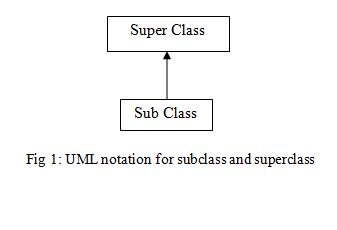CSC/ECE 517 Fall 2012/ch1b 1w46 sm
Subclassing
Subclassing
Subclassing is a principle of creating a specialization(subclass/ [1]) of a base class(superclass/ parent class) by inheriting the methods and instance data from the base class. Subclassing is one of the significant features of OO programming, which greatly increases the reusability of classes and also minimizes duplication of code. A subclass usually inherits some properties from a super class. Inheritance is a design principle in object oriented languages like Java. The reason behind inheritance is to reuse the code of existing objects or establish a subtype from an object. This greatly improves the efficiency and makes the code more readable as methods which are written only once can be used by a lot of subclasses. A superclass consists of common features that can be extended over subclasses. Superclass and subclass are commonly called base and derived class. The relationship between a subclass and superclass can be represented by a simple UML diagram as shown below.
Examples of Subclassing
The following example illustrates method overriding in Java.
public class Base{
public String printName(){
System.out.println("Base Class");
}
}
public class Child extends Base{
public String printName(){
System.out.println("Child Class");
}
}
public class Test{
public static void main(String args[]){
Base b = new Base();
b.printName(); //prints "Base class"
Child c = new Child();
c. printName(); //prints "Child class"
b = c;
b.printName(); //prints "Child class"
}
}
The following example illustrates subclassing in C++
#include <iostream.h>
class Base {
public :
virtual void printName() {
cout << "Base Class";
}
};
class Child:public Base {
public :
void printName() {
cout << "Child Class";
}
};
void main() {
Base b;
Child c;
Base *b2 = new Child();
b.printName();
c.printName();
b2->printName();
}
Advantages of Subclassing
Reusability
By creating subclass, the code of the base class can be reused in many situations. This gives subclass the freedom to create more specialized functions. It can use the base class methods to create these special functions. Apart from avoiding code duplication, this helps in decreasing the file size thereby saving some memory space.
For instance, we maybe programming animal characteristics but there is a special class of animals called mammals. Mammals display some specialized functions which can be defined in the subclass. As per Liskov Substitution principle which is discussed later, mammals obey the constraints enforced by the animal class and hence this kind of implementation avoids code duplication.
Polymorphism
This allows multiple definitions for the same method depending on the object it is invoked on. Subclasses of a class can define their own unique behaviors and yet share some of the same functionality of the parent class. For example,
public class Car{
public String getEngineType(){
return "Basic"
}
}
public class Mercedes extends Car{
public String getEngineType(){
return "Advanced"
}
}
public class BMW extends Car{
public String getEngineType(){
return "Moderate"
}
}
public class Tester{
public static void main(String[] args){
Car c = new Car();
c.getEngineType();// returns "Basic"
c = new Mercedes();
c.getEngineType();// returns "Advanced"
c = new BMW();
c.getEngineType();// returns "Moderate"
}
}
In the above example, even though we have used the same variable type, the actual method invocation at runtime invokes the appropriate object's method and not the method defined by the variables's type.
Disadvantages of Subclassing
Tight Coupling
The subclasses are tightly coupled to the base class and as a result cannot be reused as a stand-alone class.
Independently Not Modifiable
If a method signature in the base class changes, we need to make changes in all the subclasses where the method is overrriden.
Multiple Inheritance Problem
When a subclass inherits from more than one parent and both parents have the same method signature, then a conflict arises when we invoke the method on the subclass object.
#include <iostream.h>
class Base1 {
public :
void printName() {
cout << "Base1 Class";
}
};
class Base2 {
public :
void printName() {
cout << "Base2 Class";
}
};
class Child:public Base1, Base2 {
};
void main() {
Child *c = new Child();
c->printName();
}
In the above example, the method PrintName is invoked on a child object. But, a conflict arises as to which method of the two parents needs to be invoked
Conclusion
Subclassing provides an elegant way to capture the hierarchical relationship among classes and promotes code reuse by defining common behavior in the base class and only providing the variations in the subclasses. Code reuse should not be the only reason for subclassing and the subclass should satisfy IS-A relationship.
References
http://docs.oracle.com/javase/tutorial/java/IandI/polymorphism.html http://en.wikipedia.org/wiki/Inheritance_(object-oriented_programming) http://expertiza.csc.ncsu.edu/wiki/index.php/CSC/ECE_517_Fall_2011/ch6_6b_ss http://expertiza.csc.ncsu.edu/wiki/index.php/CSC/ECE_517_Fall_2011/ch6_6b_ra
